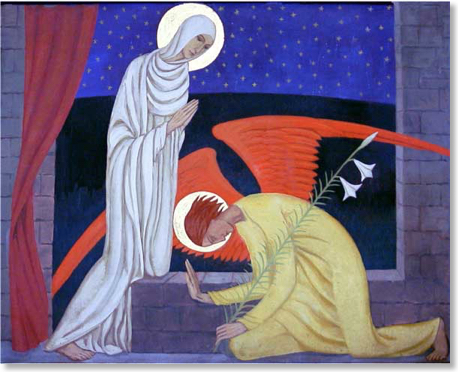Howton Grove Priory | Mobile WebsiteSharing a Vocation with the World . . .
Annunciation 2010

The Solemnity of the Annunciation of the Lord is one of the most attractive feasts in the Church calendar. There is always something fresh to ponder in Luke's account (1.26-38), while the abundance of music, poetry and art devoted to this subject is amazing. We must not lose sight of the fact, however, that we are remembering an event in history which was to have consequences for us all. Our salvation, and that of the whole world, hung upon the readiness of an obscure young girl (perhaps as young as twelve or thirteen) to do what God asked of her. All the Fathers agree that Mary's consent was necessary for the Redemption to take place. That does not mean that God would not have redeemed us had Mary not given her consent but that God foresaw her acceptance from all eternity (cfr St Thomas, Summa III.30). It was indeed a moment of unequalled faith: of Mary in God, and of God in Mary.
Recently I learned that there is a delightful legend said to come from Nazareth. The Angel Gabriel found Mary sitting by a fountain. Not surprisingly, his appearance startled her and she fled from him in fear. He followed her into the house to deliver his message, which is why the Annunciation is often depicted as taking place inside. In fact, the iconography of the Annunciation is a fascinating study in itself. Early Christian depictions usually show Gabriel as an angel of the Old Testament, severe and terrifying, before whom Mary kneels tremblingly. From about the twelfth century onwards, a new lyricism transforms the scene. The stiff hieratic forms yield to something much more youthful and human. Now Gabriel kneels before Mary. To be the Mother of God is to be exalted above the angels. Paradoxically, it is Mary's humility and obedience that lifts her so high.
A podcast about the Annunciation has been posted here.
Nov 2010
Oct 2010
Sep 2010
Aug 2010
Jul 2010
Jun 2010
May 2010
Apr 2010
Mar 2010
Feb 2010
Jan 2010
Dec 2009
Nov 2009
Oct 2009
Sep 2009
Aug 2009
Jul 2009
Jun 2009
May 2009
Apr 2009
Mar 2009
Feb 2009
Jan 2009
Dec 2008
Nov 2008
Oct 2008
Sep 2008
Aug 2008
Jul 2008
Jun 2008
May 2008
Apr 2008
Mar 2008
Feb 2008
Jan 2008
Dec 2007
Nov 2007
Oct 2007
Sep 2007
Aug 2007
Jul 2007
Jun 2007